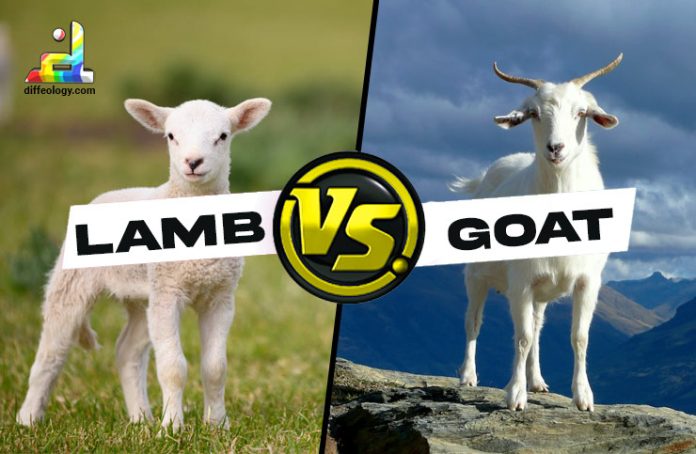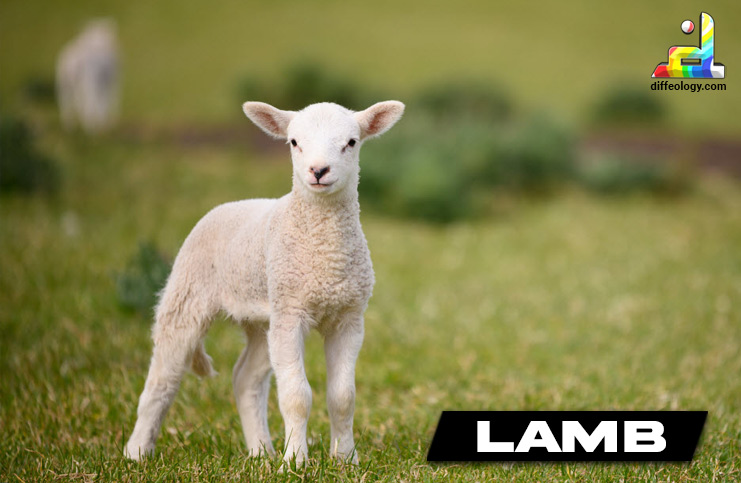It is difficult to tell the Difference between Lamb and Goat, particularly if you are unfamiliar with them or have never had any interaction with them. Goats and lambs vary greatly in a number of important ways. Goats may be any age of goat. However, lambs are thought of as young sheep. Lambs and goats have rather distinct appearances as well. Lambs have white, woolen coats, whereas goats have hair instead of wool and may be in a range of colors. However, this is just the start of their disagreements.
The Bovidae family includes both goats and sheep and as such, they share many similar traits. Both the hooves and the herbivorous diet of these animals are reminiscent of those of ruminants. Sheep and goats have roughly comparable flesh, albeit mature sheep’s meat is significantly oilier and tastes stronger than mature goat meat.
Now, let’s speak more precisely about what makes these two species different.
The Main Difference Between Lamb and Goat
Lamb is the meat of a young sheep; therefore, it is soft, has a mild flavor, and has a pale pink color. Common preparation methods include grilling and roasting. Goat meat, in contrast, has a more robust flavor—almost gamy, in my opinion—and may be substituted for red meat in many recipes.
Lamb Vs. Goat
What is a Lamb?
It is a baby sheep. It’s a young sheep that is typically less than one year old. Their wool is in great demand due to its superior softness and adaptability in a variety of textile applications. Their meat, known as lamb, is raised on farms and utilized as a protein source in a huge range of dishes.
Also, they are usually very cute and playful animals. You may feed them on grass and other plants at a farm or in a pasture. They begin as little lambs and develop into huge adult sheep. Farmers and shepherds often care for them to ensure their fitness. It is because they provide valuable products like wool and meat, making them important in agriculture.
Read Also: Difference Between Sheep and Lamb
So, It is a young sheep that is less than one year old. People cherish them for their soft wool and also raise them for their meat. Farmers commonly find adorable lambs on their farms and take care of them until they become adult sheep.
What is a Goat?
Goats are intriguing and flexible domesticated animals that have been maintained by humans for thousands of years. These mammals are warm-blooded, possess hair or fur, and give birth to live young ones. They come in various sizes, shapes, and colors, but they typically have two curved horns on their heads and cloven hooves, which means their feet are split into two parts, like a “V.”
One of the most remarkable things about them is their adaptability. They can thrive in a wide range of environments, from deserts to mountains to grasslands. Also, they are herbivores, which means they eat plants like grass, leaves, and shrubs. They have a special stomach with four compartments that help them digest tough and fibrous plant materials efficiently.
Read Also: Difference Between American Bulldog And Pitbull
People raise them for various purposes. Many individuals keep them for their milk, as it is rich in nutrients. Also, they can use them to make cheese and yogurt. Others raise them for their meat, which is lean and protein-packed. They also provide valuable materials like wool and leather.
Difference Between Lamb and Goat in Detail
Species and Origin
People typically raise lambs as young sheep, usually less than one year old. Humans have domesticated sheep for thousands of years, and historians believe these animals originated in the Middle East. People have raised them for their meat, wool, and milk in various parts of the world.
On the other hand, humans raise goats, which belong to a different species entirely. Goats are part of the genus Capra and have a distinct lineage compared to sheep. Historians believe that people domesticated goats around the same time as sheep and that goats have a broader geographical distribution, with origins in Asia, Europe, and Africa. People raise them for their meat, milk, and fiber (cashmere and mohair).
Physical Characteristics
Lambs are generally smaller in size compared to goats. They have a more compact body, shorter legs, and a rounder, woolly appearance. People describe the texture and color of lamb meat as varying depending on the breed and diet, but it’s often tender, mild, and lean.
People typically find goats to be larger than lambs, with longer legs and a more slender body. Some goat breeds may have hair instead of wool. Goat meat, often referred to as “chevon” or “mutton,” can vary in texture and flavor, but it’s generally leaner and has a stronger, slightly gamey taste compared to lamb.
Diet and Feeding Habits
Sheep primarily graze, meaning they feed primarily on grass and other vegetation. Their digestive system efficiently breaks down cellulose in plants. The diet shapes the mild flavor of lamb meat as it gets influenced by the forage and pasture that lambs consume. On the other hand, goats, being more versatile in their diet, are considered browsers.
They tend to eat a wider variety of plants, including leaves, shrubs, and even woody vegetation. This varied diet can lead to a more complex and sometimes stronger flavor in goat meat. People often use goats to control overgrown vegetation in some regions due to their preference for brushy plants.
Culinary Uses and Cultural Significance
People from various parts of the world enjoy lamb meat in many cuisines. They commonly use it in dishes like lamb chops, kebabs, stews, and curries. In some cultures, lamb holds religious or cultural significance, such as in Middle Eastern and Mediterranean cuisine.
Goat meat is also a favorite in various parts of the world, particularly in African, Caribbean, and South Asian cuisines. People use it in dishes like goat curry, jerk goat, and birria. Many people often favor goat meat for its rich, bold flavor, which adds depth to many traditional recipes.
Availability and Price
Most supermarkets and butcher shops in many Western countries generally make lamb meat more readily available. The price of lamb can vary depending on factors like the cut, quality, and region, but it tends to be moderately priced.
While Western supermarkets may have less goat meat, it’s readily available in ethnic markets and communities where it is a staple. The price of goat meat can also vary but is often competitive with other meats. It may be more affordable in regions where goat farming is common.
Age at Harvest
Farmers usually slaughter lambs when they are less than one year old, which makes their meat tender and mild in flavor. They typically harvest goats at a slightly older age, often around one to two years, which gives their meat a stronger and more distinct taste.
Meat Texture
People know lamb meat for its tenderness and ease of chewing due to its younger age and lower fat content. Goat meat can be a bit tougher and leaner, which can make it a bit chewier compared to lamb.
Cooking Methods
People often grill, roast, or braise lamb to enhance its delicate flavor and tender texture. Goat meat is well-suited for slow-cooking methods like stewing and simmering, which help tenderize it and develop its unique taste.
Fat Content
Lamb meat typically has a moderate amount of fat, which can vary depending on the cut. Goat meat is generally leaner and contains less fat than lamb, which can make it a healthier choice for some people.
Culinary Traditions
In Mediterranean and Middle Eastern cuisines, lamb serves as a staple and is often used in dishes like gyros, kebabs, and lamb shawarma.
Goat meat is more prevalent in African, Caribbean, and South Asian cuisines, featuring in dishes such as goat curry, biryani, and jerk goat.
Global Consumption
Many countries around the world widely consume lamb, and it has a strong presence in Western and European cuisines.
Goat meat is more popular in specific regions and cultures, making it a staple in those areas while being less common in others.
Comparison Table “Lamb Vs. Goats”
| Reasons of Distinctions | Lambs | Goats |
|---|---|---|
| Species & Origin | Young sheep of Middle Eastern origin. | Different species, origins in Asia, Europe, and Africa. |
| Physical Characteristics | Smaller, round, woolly body. | Larger, slender bodies; some have hair instead of wool. |
| Meat Characteristics | Tender, mild, and lean. | The lean, slightly gamey taste. |
| Diet & Feeding Habits | Grazers eat grass primarily. | Browsers eat a variety of including leaves and shrubs. |
| Culinary Uses | Used in lamb chops, stews, kebabs. | Used in dishes like goat curry, jerk goat. |
| Availability & Price | Widely available in Western supermarkets at a moderate price. | More available in ethnic markets, competitive price. |
| Age at Harvest | Less than one year old. | Around one to two years old. |
| Meat Texture | Tender and easy to chew. | Slightly tougher and leaner. |
| Cooking Methods | Grilling, roasting, braising. | Slow-cooking methods like stewing. |
| Fat Content | Moderate fat content. | Leaner, less fat than lamb. |
| Culinary Traditions | Mediterranean and Middle Eastern cuisines. | African, Caribbean, and South Asian cuisines. |
| Global Consumption | Consumed worldwide, a strong presence in Western cuisines | Popular in specific regions and cultures. |
Key Difference Between Lamb and Goat
- Appearance: Lambs are smaller and fluffier, with a white or light-colored fleece. Goats are generally leaner and can come in various colors, often with a rougher coat.
- Age: Lamb refers to a young sheep less than one-year-old. But goat meat can come from both young and adult goats.
- Taste: Lamb has a milder, tender, and slightly sweet flavor. Goat meat has a stronger, earthier, and sometimes gamier taste.
- Texture: Lamb meat is generally more tender and less fibrous. Goat meat can be slightly tougher and have a bit more chew.
- Cuisine: Lambs are famous in Mediterranean, Middle Eastern, and European dishes. Goat meat is popular in many Asian, African, and Caribbean cuisines.
- Cooking Methods: Lamb is often roasted, grilled, or used in stews and curries. Yet, Goat meat is often slow-cooked in curries, stews, or braised for tenderness.
- Nutrition: Lamb is slightly higher in fat and calories, but it’s also richer in protein. Goat meat is leaner, with lower fat content.
- Cultural Significance: Lamb is associated with religious celebrations in some cultures, like Easter in Christianity. Goat meat is a staple in various religious and cultural festivals in many parts of the world.
- Availability: Lamb is more widely available in Western countries. However, you can find goat meat in specialty stores or ethnic markets in some regions.
- Cost: Lamb tends to be more expensive.
FAQs:
Summary
While lamb and goat are both popular meat sources, they differ in terms of species, physical characteristics, diet, culinary uses, and availability. These distinctions can affect their taste, texture, and cultural significance in various cuisines. So, now you understand the Difference between Lamb and Goat, which can help you choose the right meat for your culinary preferences and dietary needs.
References and External Links
- ALL YOU NEED TO KNOW ABOUT LAMB
- Lamb Definition, Meaning & Synonyms, Meaning & Synonyms
- Goat – Definition, Meaning & Synonyms, Meaning & Synonyms



